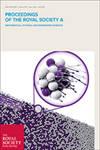一维和二维颗粒问题的半解析解
Proceedings of the Royal Society of London. Series A. Mathematical and Physical Sciences
Pub Date : 2004-08-08
DOI:10.1098/rspa.2004.1286
引用次数: 17
摘要
多孔催化球团中发生不可逆一级放热反应时的传热传质问题是化学反应器工程中研究较多的问题。该系统由温度和反应物转化率的两个耦合反应扩散方程来描述。采用伽辽金方法,得到了具有一、二维板几何形状的球团问题的半解析模型。这包括使用试函数近似球团中的温度和反应物转化曲线的空间结构。对控制偏微分方程求平均值,得到半解析模型。由于阿累尼乌斯定律不能显式积分,半解析模型由一组积分微分方程给出。半解析模型允许获得稳态温度和转换曲线以及稳态图作为超越方程集的解(积分使用正交规则计算)。利用奇异性理论和局部稳定性分析研究了半解析模型的静态和动态多重性。文中还详细讨论了一个稳定极限环的例子。与控制反应扩散方程的数值解和文献中其他结果的比较表明,半解析解是非常精确的。本文章由计算机程序翻译,如有差异,请以英文原文为准。
Semi-analytical solutions for one- and two-dimensional pellet problems
The problem of heat and mass transfer within a porous catalytic pellet in which an irreversible first–order exothermic reaction occurs is a much–studied problem in chemical–reactor engineering. The system is described by two coupled reaction–diffusion equations for the temperature and the degree of reactant conversion. The Galerkin method is used to obtain a semi–analytical model for the pellet problem with both one– and two–dimensional slab geometries. This involves approximating the spatial structure of the temperature and reactant–conversion profiles in the pellet using trial functions. The semi–analytical model is obtained by averaging the governing partial differential equations. As the Arrhenius law cannot be integrated explicitly, the semi–analytical model is given by a system of integrodifferential equations. The semi–analytical model allows both steady–state temperature and conversion profiles and steady–state diagrams to be obtained as the solution to sets of transcendental equations (the integrals are evaluated using quadrature rules). Both the static and dynamic multiplicity of the semi–analytical model is investigated using singularity theory and a local stability analysis. An example of a stable limit cycle is also considered in detail. Comparison with numerical solutions of the governing reaction–diffusion equations and with other results in the literature shows that the semi–analytical solutions are extremely accurate.
求助全文
通过发布文献求助,成功后即可免费获取论文全文。
去求助
来源期刊
自引率
0.00%
发文量
0
期刊介绍:
Proceedings A publishes articles across the chemical, computational, Earth, engineering, mathematical, and physical sciences. The articles published are high-quality, original, fundamental articles of interest to a wide range of scientists, and often have long citation half-lives. As well as established disciplines, we encourage emerging and interdisciplinary areas.

 求助内容:
求助内容: 应助结果提醒方式:
应助结果提醒方式:


